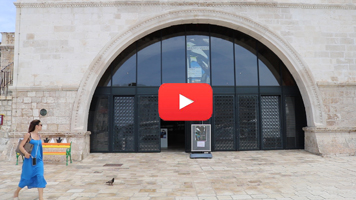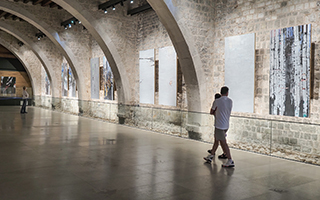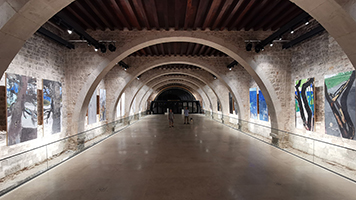WORK
Arsenal, Hvar, 2022
Tree faces
In the Museum of Contemporary Art in Zagreb, Archipelago was introduced only two years after a sort of retrospective exhibition in Lauba, that presented an analytical overview of themes and series of paintings from heterogenous artistic oeuvre of Matko Vekić. About seventy large scale paintings were on display for months. It turned out that it was not only a new series of paintings, but also a step forward of an author who has already shown that he does not avoid a challenge. Vekić did not flinch from a painting incentive in a worn-out motif of nature, nor did he withdraw from big canvas or the painting itself.
Namely, this series is a confirmation of his immersion into painting emancipated for visual art values. These are paintings on panel, whose surfaces are covered with forms composed so as to resemble details from nature; lines of tree parts or flat water surfaces resulting from a very complex painting act in which the painter applies paint testing its potentials and activating the painting surface, revealing thin layers by polishing, drawing lines, but also scratching.
Vekić sometimes uses a more subdued coloristic palette, but more potent effect is occasionally achieved by brown and black inclining towards intensive blue, green or red; also by the dominance of discreet color of immense possibilities – grey, but also black and blue planes. In the exhibition text, his stressing of “our temporal image of life“ is symptomatic, suggesting that everything is contained in such an image. It directs us to immersion of the painter into the nature motif that spoke from itself, and then as Béla Hamvas, Hungarian writer, philosopher and gardener, describes: “One can see such dreaming trees that think with eyes closed about a life that is nowhere to be found. Trees with upset faces, immersed into hidden pleasures. Their life is too poor, not because it is poor, but because it is easier to imagine; as if one bites his own destiny, as a predator bites flesh, as a liana smothers whatever it touches in its dark embrace. One can see silly trees that bend their branches as madmen and they stand out with their senseless movements, perform inappropriate dance moves, ironize themselves because they do not get along with themselves. There are pathetic trees, some are gloomy, lonely. There are idiot trees, obscene, perverse, stupid. Finally, tree faces cannot be misinterpreted.“[1]
Connotations of trees of life are diverse and deeply symbolical. They are mythical. In Biblical context, their meaning relates to the knowledge of good and evil, shelter, but also faith: “At least there is a hope for a tree: If it is cut down, it will sprout again, and its new shoots will not fail. Its roots may grow old in the ground and its stump die in the soil, yet at the scent of water it will bud and put forth shoots like a plant.“[2]
Vekić's trees are actually proven oppositions, bumpy and knotty, but with harmonious inner tensions; with bent branches or in arranged rows, forming a relation with expressive backgrounds, in compositions of tonal harmonies that are accentuated by deliberately selected raw treatment of the surface. They are expressed more through expressivity of lines than through imitation of their outer appearance. He actually shows interest in the motifs that express the depth of relations and connection of the painting with the Whole. Vekić is constantly searching for the Whole within the painting. Therefore he does not follow the theme blindly and does not withdraw from the inner drive to touch the boundaries. Black planes with intermittent scintillations of yellow light might remind us of moonlight, but also of human impact on flora and fauna, such as lack of oxygen in the sea due to major oil spill.
However, “in the time of threatening nonsense, art helps (even in what seems senseless) to make the question of sense still present and to provoke and confront the question of sense.“[3] Although it usually does not have an answer to a question like: „Is it possible to outdo what has been tried before? “[4], these are still very attractive authentic attempts. In that regard, assumption that Vekić's exhibition in Lauba is “a possible 'boundary stone' in his creative life“ mentioned in a conversation we had on that occasion for Kontura, might prove to be well founded, but that can only be discovered with the whole.
His fidelity to métier helped him to sense the hidden in the field of the painting, and to paint with freshness regardless of the motif, always with articulated painting approach. Owing to the maturity that Matko Vekić has reached in the field of visual arts, he belongs among the most prominent individuals in Croatian painting in the last few decades.
Nevenka Šarčević
[1]Jasmin i maslina, (translated by Jadranka Damjanov, Ivan Ladislav Galeta, Stjepan Filaković), Ceres, Zagreb, 1999.
[2] (Job 14,7-9)
[3] Hans Küng, Kunst und Sinnfrage, Zürich, 1980, p. 61
[4] Cf. note 3, p.14


